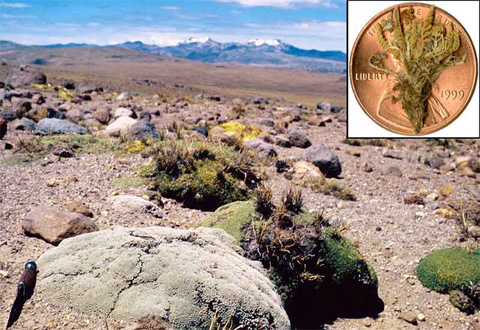High in the towering Andes Mountains of Peru, Professor Hugh Iltis was on his hands and knees looking for the haze filter that had fallen off his camera. Like Gulliver amid the Lilliputians, he stared at a miniaturized world through his hand lens. The year was 1962. The tiny plant was no more than a centimeter tall.
Iltis pulled up a few tiny tufts from their droughty lodging and, under the hand lens, saw that they were in flower. Upon evening-time inspection in the tent, he realized that the diminutive plants must be violets—the smallest he had ever seen or heard of.
On a rocky alpine tundra strewn with huge basalt borders, the tiny violet was among the small plants growing in the bare soil and gravel on an inter-mountain plateau high in the western Andes. Iltis collected the plant specimen—so small that the entire plant, roots and all, could fit on a penny—and returned to the University of Wisconsin—Madison in early 1963. He studied the tiny plant and the already-classified Andean violets, but found no satisfactory matches.
The matter was left unresolved until nearly 30 years later in 1992, when [Harvey] Ballard, who was then a new Ph.D. student at UWMadison Botany Department, met Iltis while conducting revisionary studies on Latin American Viola. Together, the authors delved anew into species descriptions of Wilhelm Becker (1906, 1909, 1922, 1928), violet treatments for Peru by Baehni and Weibel (1941) and Macbride (1941), and protologues of previously published names for other New World violets. Over the next decade [Ballard] located and examined type material and herbarium collections of all of the potentially relevant names for South American violets and evaluated species circumscriptions of described species against Iltis’s tiny species. He determined that the latter was both utterly distinct and undescribed.
Another 20 years passed before Ballard, now at Ohio University, and Iltis completed their studies and published their classification of a new species: Viola lilliputana, aptly named after Jonathan Swift’s Lilliputians in Gulliver’s Travels. Their December 2012 paper, “Viola lilliputana sp. nov. (Viola sect. Andinium, Violaceae), one of the world’s smallest violets, from the Andes of Peru,” describes the extreme conditions in which the species grows—a high altitude environment with subzero nighttime temperatures and little to no rain.
“In order to be certain the tiny violet that Dr. Iltis collected was in fact truly unique, we needed to study all of its nearest relatives. That took quite a few years, because we had to examine many museum collections located around the world, representing the several violet species most similar to it growing in the Andes of Peru and surrounding countries, and compare Iltis’s violet with them trait by trait, often doing microscopic work on flowers and other structures that were too small to view with the naked eye,” says Ballard. “Some collections were in European musuems in Paris, Munich and London, and it took a long time to get funding to see those collections (some museums do not send type specimens, the original collections a species is named from).
‘More Wonders Yet to be Found’
“In the process of studying Iltis’s tiny violet, other collaborators and I have found six other new species of high Andean violets that are new to science as well!” notes Ballard. “We will be naming these additional new violets, belonging to the same species group as Viola lilliputana, in a separate manuscript during the upcoming year. It has been fascinating to study this complex of lobed-leaved violets in the Andes, and to realize that each time a botanist makes a new trek into that region of the world, more new species are found. It makes one ponder whether our estimates of species diversity for flowering plants—often estimated at around 270,000 species worldwide—is perhaps a sizable underestimate, and suggests to me that there are many more wonders yet to be found, certainly in some of the more remote regions of the planet but possibly even in our own backyards.”
Top 10 New Species in the World
In May, the tiny Viola lilliputana violet from the high Andes of Peru was chosen as one of the Top 10 New Species by an international committee of taxonomists.
Ballard, Associate Professor of Plant Systematics and Evolution, thanks Ohio University undergraduates Jill Brown ’00, David May ’01 and Anya Porter ’02 for research assistance that contributed to investigations on Central Andean Andinium violets. He also acknowledges financial support from Ohio University’s Baker Fund, the Ohio University Honors Tutorial College, and NSF Research Experiences for Undergraduates. Ballard is also Director of the Floyd Bartley Herbarium and Curator of Vascular Plants at Ohio University’s Department of Environmental and Plant Biology in the College of Arts & Sciences.
Brown is a 2000 graduate of the Honors Tutorial College, majoring in Plant Biology. She was employed for a year on an HTC apprenticeship. May is a 2001 graduate of the College of Arts & Sciences, majoring in Plant Biology—Applied Ecology. He was employed for a year on an NSF REU (Research Experiences for Undergraduates supplement) as part of a grant Ballard received. Porter is a 2002 graduate of the College of Fine Arts, majoring in dance. She was employed for a year on an HTC apprenticeship.
Quentin Wheeler, Director of the International Institute for Species Exploration at Arizona State University, writes on “New to nature special: the top 10 new species” in the Guardian:
On 23 May,the International Institute for Species Exploration announced the annual top 10 new species for the sixth time. A committee of taxon experts led by Dr Antonio Valdecasas of the Museo Nacional de Ciencias Naturales in Madrid made the final selections. The list is a kind of scientific shock-and-awe campaign, shocking us at what we did not know about our own planet and leaving us in awe over the diversity, complexity, wonder and beauty of the living world. From new species of black-staining fungi that threatened the Palaeolithic cave paintings at Lascaux, France to the first old-world monkey to be discovered in Africa in 28 years, a beautiful shrub from Madagascar’s disappearing littoral forests, a bioluminescent cockroach, and a violet from the high Andes that is barely 1cm tall, we are struck that the depth of Earth’s living diversity is matched only by our ignorance of it….
We announce the top 10 on or about Carl Linnaeus’s birthday on 23 May as a homage to his incredible, inspiring vision of an inventory of Earth’s flora and fauna. When he conceived and set out on his inventory in the middle of the 18th century, it was a dream impossibly larger than he could have imagined. The 10,000 or so species known to him are outnumbered nearly two to one by the new species we name each year, and we have yet to become serious about completing this enterprise. Technological advances, particularly in cyberinfrastructure, have quietly chiselled away at all the constraints of access to travel, colleagues, collections, literature, and data that held back Linnaeus and the generations of taxonomists who have followed. With investments in natural history museums, taxonomic research infrastructure, and inspiring and educating the next generation of species explorers we can discover and describe most of the estimated 10m-12m “higher” plant and animal species in less than 50 years. Baseline data on what species exist and where will empower us to detect, monitor, and respond to changes in biodiversity and make effective public policies. If you liked the top 10, imagine announcing the top 10 million.
Read the Guardian article and Arizona State University’s news release announcing the top 10 new species.
Lilliputian Violet
Viola lilliputana
Country: Peru
Tiny violet: Not only is the Lilliputian violet among the smallest violets in the world, it is also one of the most diminutive terrestrial dicots. Known only from a single locality in an Intermontane Plateau of the high Andes of Peru, Viola lilliputana lives in the dry puna grassland eco-region. Specimens were first collected in the 1960s, but the species was not described as new until 2012. The entire above-ground portion of the plant is barely 1 centimeter tall. Named, obviously, for the race of little people on the island of Lilliput in Jonathan Swift’s “Gulliver’s Travels.”
Reference:
Ballard, H. E. and H. H. Iltis. 2012. Viola lilliputana sp. Nov. (Viola sect. Andinium, Violaceae), one of the world’s smallest violets, from the Andes of Peru. Brittonia 64(4), 353-358.



















Comments